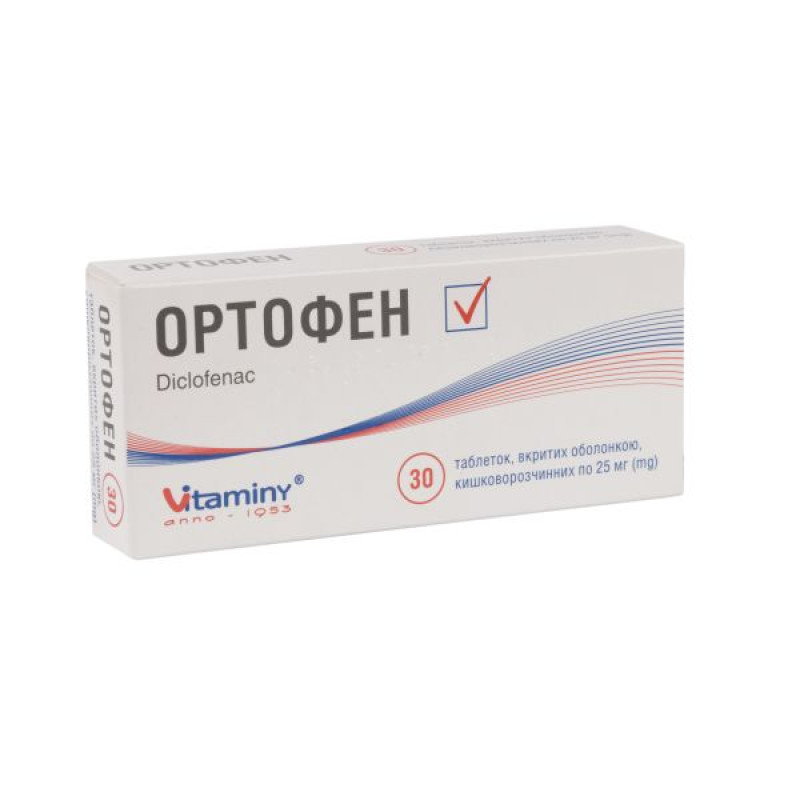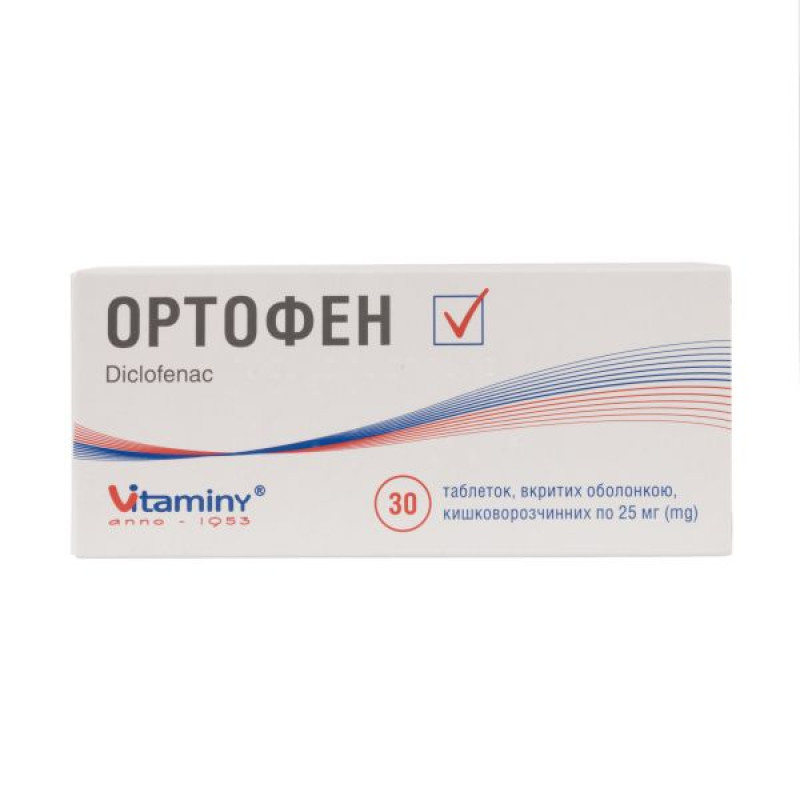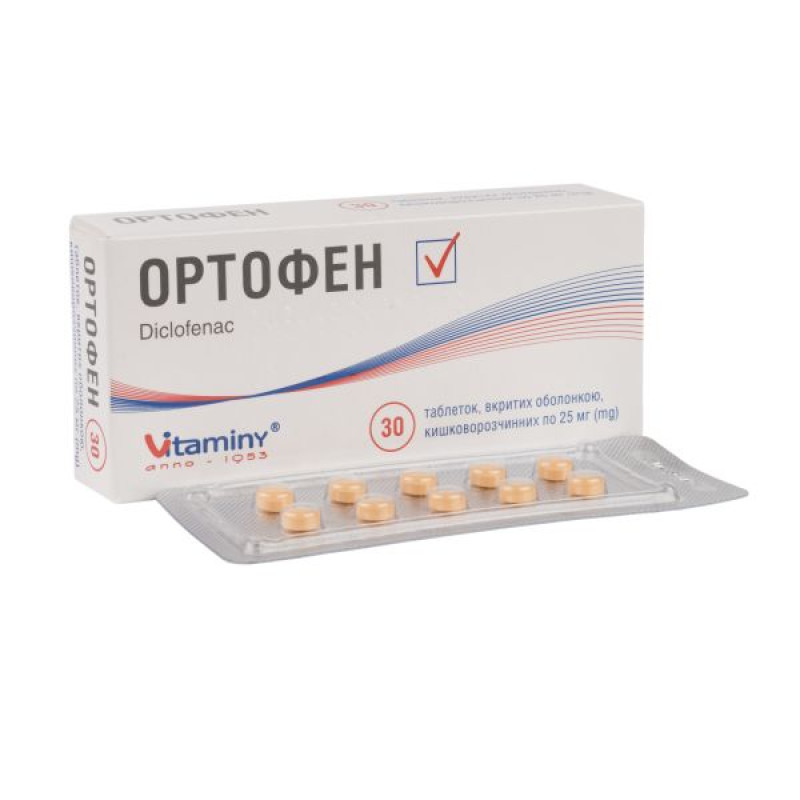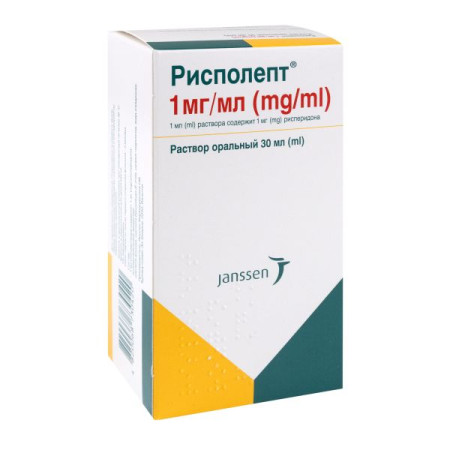Ortofen enteric-coated tablets 0.025 g blister No. 30

Instructions for Ortofen enteric-coated tablets 0.025 g blister No. 30
Composition
active ingredient: diclofenac;
1 tablet contains diclofenac sodium in terms of 100% substance 25 mg;
excipients: lactose, monohydrate; sugar; povidone; potato starch; stearic acid; coating acrylic-iz yellow 93O38159 (which contains: methacrylate copolymer (type C), talc, titanium dioxide (E 171), triethyl citrate, quinoline yellow (E 104), colloidal anhydrous silica, sodium bicarbonate, sodium lauryl sulfate, iron oxide yellow (E 172), ponceau 4R (E 124)).
Dosage form
The film-coated tablets are enteric-coated.
Main physicochemical properties: round tablets with a biconvex surface, covered with a light yellow to yellow coating. When broken, when examined under a magnifying glass, a core surrounded by a solid layer is visible.
Pharmacotherapeutic group
Nonsteroidal anti-inflammatory and antirheumatic drugs. Acetic acid derivatives and related compounds. ATC code M01A B05.
Pharmacological properties
Pharmacodynamics.
Ortofen contains diclofenac sodium and is a non-steroidal anti-inflammatory drug (NSAID) with pronounced analgesic, anti-inflammatory and antipyretic effects. The main mechanism of action is inhibition of the biosynthesis of prostaglandins (prostaglandin synthetase, cyclooxygenase), which play a major role in the occurrence of inflammation, pain and fever.
In vitro, at concentrations equivalent to those achieved in humans, diclofenac does not inhibit proteoglycan biosynthesis in cartilage tissue.
Ortofen tablets, due to their rapid absorption, are appropriate in the treatment of acute conditions accompanied by pain and inflammation, in which a rapid onset of action of the drug (within 30 minutes) is desirable. In post-traumatic pain and inflammation, diclofenac quickly relieves both spontaneous pain and pain with movement, and also reduces swelling during inflammation and swelling in the wound area.
In addition, the active substance can relieve pain and reduce bleeding in primary dysmenorrhea. Diclofenac also provides analgesic effects in other conditions accompanied by moderate to severe pain.
Pharmacokinetics.
Absorption.
Diclofenac is rapidly and completely absorbed. Absorption begins immediately after administration of the drug, and the amount absorbed is similar to that absorbed after an equivalent dose of diclofenac sodium. Administration of the drug with food does not affect the amount of diclofenac absorbed, although the onset and rate of absorption may be somewhat delayed.
Bioavailability.
About half of the administered diclofenac is metabolized during the first passage through the liver (first-pass effect); the area under the concentration curve (AUC) after oral administration is approximately half of the value obtained with an equivalent parenteral dose.
The pharmacokinetic characteristics of the drug do not change with repeated administration. Accumulation does not occur if the recommended dosage is observed.
Distribution.
Diclofenac is 99.7% bound to serum proteins, mainly albumin (99.4%). The volume of distribution is 0.12-0.17 l/kg.
Diclofenac penetrates into the synovial fluid, where its maximum concentration is reached 2-4 hours after reaching peak values in the blood plasma. The apparent half-life from the synovial fluid is 3-6 hours. 2 hours after reaching peak levels in the blood plasma, the concentration of the active substance in the synovial fluid is higher than in the blood plasma, and remains so for another 12 hours.
Biotransformation.
The biotransformation of diclofenac occurs partly by glucuronidation of the intact molecule, but mainly by single and multiple hydroxylation and methoxylation, leading to the formation of several phenolic metabolites, most of which form conjugates with glucuronic acid. Two of these phenolic metabolites are biologically active, but much less so than diclofenac.
Breeding.
The total systemic clearance of diclofenac from plasma is 263 ± 56 ml/min (mean ± standard deviation). The terminal plasma half-life is 1-2 hours. The plasma half-life of the four metabolites, including two pharmacologically active ones, is also short and is 1-3 hours. The inactive metabolite has a much longer half-life.
Approximately 60% of the administered dose is excreted in the urine as the glucuronide conjugate of the intact molecule and as metabolites, most of which are also converted to glucuronide conjugates. Less than 1% of diclofenac is excreted as unchanged substance. The remainder of the administered dose is excreted as metabolites in the bile and feces.
Pharmacokinetics in certain patient groups.
Elderly patients: No significant differences in absorption, metabolism, and excretion of the drug were observed depending on the patient's age.
In patients with creatinine clearance less than 10 ml/min, the theoretical steady-state plasma concentrations of hydroxylated metabolites were approximately 4-fold higher than in healthy subjects. However, these metabolites are ultimately excreted in the bile.
Patients with liver disease. In patients with chronic hepatitis or compensated cirrhosis, the pharmacokinetics and metabolism of diclofenac are similar to those in patients without liver disease.
Clinical characteristics.
Indication
- Inflammatory and degenerative forms of rheumatic diseases (rheumatoid arthritis, ankylosing spondylitis, osteoarthritis, spondyloarthritis);
- pain syndromes in the spine;
- rheumatic diseases of extra-articular soft tissues;
- acute attacks of gout;
- post-traumatic and postoperative pain syndromes accompanied by inflammation and edema, for example after dental and orthopedic interventions;
- gynecological diseases accompanied by pain and inflammation, for example, primary dysmenorrhea or adnexitis;
- as an adjuvant for severe inflammatory diseases of the ENT organs, which are accompanied by pain, for example, with pharyngotonsillitis, otitis.
According to general therapeutic principles, the underlying disease should be treated with basic therapy. Fever alone is not an indication for the use of the drug.
Contraindication
- Hypersensitivity to the active substance or to any other components of the drug;
- Ortofen, like other nonsteroidal anti-inflammatory drugs, is contraindicated in patients who experience attacks of bronchial asthma, angioedema, urticaria or acute rhinitis, nasal polyps and other allergic symptoms in response to the use of ibuprofen, acetylsalicylic acid or other NSAIDs;
- acute gastric or intestinal ulcer and/or duodenal ulcers, gastrointestinal bleeding or perforation;
- stomach or intestinal disease; gastrointestinal bleeding or perforation;
- history of gastrointestinal bleeding or perforation related to previous treatment with nonsteroidal anti-inflammatory drugs (NSAIDs);
- active ulcer/bleeding or history of recurrent ulcer/bleeding (two or more separate episodes of established ulcer or bleeding);
- inflammatory bowel diseases (e.g. Crohn's disease or ulcerative colitis);
- liver failure;
- renal failure;
- congestive heart failure (NYHA II-IV);
- ischemic heart disease in patients with angina pectoris who have had a myocardial infarction;
- cerebrovascular diseases in patients who have had a stroke or have episodes of transient ischemic attacks;
- peripheral artery disease;
- treatment of perioperative pain during coronary artery bypass grafting (or use of a cardiopulmonary bypass machine).
Special safety measures.
General warnings
To minimize undesirable effects, treatment should be initiated at the lowest effective dose for the shortest period of time necessary to control symptoms.
The concomitant use of Ortofen and other systemic NSAIDs, including selective COX-2 inhibitors, should be avoided, as there is no evidence of synergistic benefits and due to the occurrence of additional side effects.
Caution is required when used in patients over 65 years of age. In particular, it is recommended to prescribe the lowest effective doses in physically frail elderly patients or if the patient's body weight is below normal.
To reduce the risk of gastrointestinal ulceration, bleeding or perforation, which can occur at any time during treatment with NSAIDs, regardless of their selectivity for COX-2 and even in the absence of warning symptoms or predisposing factors in history, the lowest effective dose should be used for the shortest possible period of time.
Patients with digestive tract disorders, liver dysfunction, or a suspected history of gastric or intestinal ulcer should use this drug only if absolutely indicated and under close medical supervision.
The effect of NSAIDs on the kidneys causes fluid retention and edema and/or hypertension. Therefore, diclofenac should be used with caution in patients with cardiac disorders or other conditions predisposing to fluid retention. Use with caution in patients receiving concomitant diuretics or ACE inhibitors or at increased risk of hypovolemia.
As with other NSAIDs, allergic reactions (including anaphylactic/anaphylactoid reactions) may rarely develop, even without prior use of diclofenac.
Like other NSAIDs, Ortofen, due to its pharmacodynamic properties, may mask the signs and symptoms of infection.
In accordance with generally accepted approaches to the treatment of infectious and inflammatory diseases, it is also necessary to use etiotropic agents. An isolated increase in body temperature is not an indication for the use of the drug.
Ortofen tablets contain lactose. Therefore, they should not be prescribed to patients with rare hereditary forms of galactose intolerance, glucose-galactose malabsorption syndrome or severe lactase deficiency.
Effect on the digestive tract.
Gastrointestinal bleeding (hemorrhage, melena), ulceration or perforation, which can be fatal, can occur at any time during treatment, with or without warning symptoms, or in patients with a history of serious gastrointestinal events. In general, such events are most dangerous in elderly patients. In cases where patients taking Ortofen develop these complications, the drug should be discontinued.
As with other NSAIDs, including diclofenac, close medical supervision and special caution are necessary when prescribing Ortofen to patients with symptoms indicating gastrointestinal disorders or with a history of ulcer, bleeding or perforation of the stomach or intestines. The risk of bleeding, ulceration or perforation of the digestive tract increases with increasing dose of NSAIDs, including diclofenac. As well as in patients with a history of ulcer, especially if there was a complication (bleeding or perforation), and in elderly patients (cases may be fatal).
To reduce the risk of gastrointestinal toxicity, treatment in such patients should be initiated and maintained at the lowest effective dose. For such patients, as well as for patients requiring concomitant use of acetylsalicylic acid-containing drugs or other drugs that increase the risk of gastrointestinal toxicity, combination therapy with protective agents (e.g., proton pump inhibitors or misoprostol) should be considered. Patients with a history of gastrointestinal toxicity, especially the elderly, should report any unusual abdominal symptoms (especially gastrointestinal bleeding). Caution should be exercised in patients receiving concomitant medications that may increase the risk of ulceration or bleeding, such as systemic corticosteroids, anticoagulants (e.g., warfarin), antithrombotic agents (e.g., ASA), or selective serotonin reuptake inhibitors.
Effect on the liver.
When prescribing Ortofen to patients with impaired liver function, constant medical supervision should be ensured, as their condition may worsen.
As with other NSAIDs, including diclofenac, one or more liver enzymes may increase. This has been observed very commonly with diclofenac, but has rarely been associated with clinical symptoms. In most cases, increases to borderline levels were observed. These increases were often mild, while the incidence of severe increases remained around 1%. The increase in liver enzymes was associated with clinical signs of liver damage in 0.5% of cases. The increase in enzyme levels was usually reversible after discontinuation of the drug.
It should be noted that Ortofen is recommended only for short-term treatment (no more than 2 weeks). In the case of long-term use of diclofenac, regular monitoring of liver function and liver enzyme levels is a precautionary measure. The use of this drug should be discontinued if liver function is impaired or worsened, if clinical signs or symptoms suggestive of liver disease develop, or if other symptoms occur (e.g. eosinophilia, rash). Diseases such as hepatitis may occur without prodromal symptoms.
In addition to elevated liver enzymes, severe hepatic reactions, including jaundice and fulminant hepatitis, hepatic necrosis and hepatic failure, some of which were fatal, have been reported rarely.
Diclofenac should be used with caution in patients with hepatic porphyria due to the possibility of provoking an attack.
Effect on the kidneys.
Long-term use of high doses of NSAIDs, including diclofenac, often (1-10%) leads to edema and arterial hypertension.
Particular caution should be exercised in patients with impaired cardiac or renal function, a history of arterial hypertension, elderly patients, patients who are simultaneously taking diuretics or drugs that can significantly affect renal function, as well as patients with a significant decrease in extracellular fluid volume, for example, before/after surgery. When prescribing Ortofen in such cases, renal function should be monitored. After discontinuation of therapy, the patient's condition usually normalizes.
Effect on the skin.
Serious skin reactions (in some cases fatal), including exfoliative dermatitis, Stevens-Johnson syndrome and toxic epidermal necrolysis, have been reported very rarely in association with the use of NSAIDs, including Ortofen. Patients are at greatest risk of developing such reactions at the beginning of treatment and usually occur within the first month of treatment. Ortofen should be discontinued at the first sign of rash, mucosal lesions or any other sign of hypersensitivity.
SLE and mixed connective tissue diseases.
Patients with systemic lupus erythematosus (SLE) and mixed connective tissue diseases may be at increased risk of developing aseptic meningitis.
For patients with a history of hypertension and/or mild to moderate congestive heart failure, appropriate monitoring and advice is necessary, as fluid retention and oedema have been reported in association with the use of NSAIDs, including diclofenac.
An increased risk of thrombotic and cerebrovascular complications has been reported with selective COX-2 inhibitors. It is currently unclear whether this risk is directly related to the COX-1/COX-2 selectivity of the individual NSAIDs. Since there are currently no comparable data on long-term treatment with diclofenac at maximum doses, the existence of such an increased risk cannot be excluded. Until such data are available, the risk-benefit ratio should be carefully assessed before prescribing diclofenac to patients with clinically proven coronary heart disease, cerebrovascular disorders, obliterating peripheral arterial disease or significant risk factors (e.g. hypertension, hyperlipidemia, diabetes mellitus, smoking).
Diclofenac should only be prescribed to patients with significant risk factors for cardiovascular events (such as hypertension, hyperlipidemia, diabetes mellitus, smoking) after careful clinical evaluation. Since the cardiovascular risks of diclofenac may increase with increasing dose and duration of treatment, it should be used for the shortest possible period and at the lowest effective dose. The patient's need for diclofenac to relieve symptoms and the response to therapy should be periodically reviewed.
It is not recommended to prescribe diclofenac to patients with uncontrolled arterial hypertension, congestive heart failure, stable ischemic heart disease, peripheral artery disease and/or cerebrovascular disease; if necessary, use is possible only after a careful risk-benefit assessment and only in a dosage of no more than 100 mg per day.
Patients should be informed of the possibility of serious antithrombotic events (chest pain, shortness of breath, weakness, speech disorders) that may occur at any time. In this case, a doctor should be consulted immediately.
Effect on hematological parameters.
Ortofen is recommended for short-term treatment only. If this drug is prescribed for a longer period, it is recommended (as with other NSAIDs) to regularly monitor the blood count.
Like other NSAIDs, diclofenac may temporarily inhibit platelet aggregation, therefore, patients with impaired hemostasis, hemorrhagic diathesis or hematological disorders should be carefully monitored.
History of bronchial asthma.
In patients with bronchial asthma, with seasonal allergic rhinitis, swelling of the nasal mucosa (e.g. nasal polyps), chronic obstructive pulmonary disease (COPD) or chronic respiratory tract infections (especially with manifestations similar to symptoms of allergic rhinitis) when taking NSAIDs, side effects such as exacerbation of bronchial asthma (so-called analgesic intolerance or analgesic asthma), angioedema, urticaria occur more often than in other patients. In this regard, special precautions are recommended for such patients (readiness to provide emergency care). The above also applies to patients with allergic manifestations when using other drugs, e.g. rash, itching, urticaria.
Like other drugs that inhibit prostaglandin synthetase activity, diclofenac sodium and other NSAIDs can provoke the development of bronchospasm when used in patients with bronchial asthma or patients with a history of bronchial asthma.
Fertility.
Like other NSAIDs, Ortofen may affect female fertility and is therefore not recommended for women attempting to conceive. The drug should be discontinued in women who are unable to conceive or in women undergoing investigation for infertility.
Interaction with other medicinal products and other types of interactions
The following types of interactions have been observed with the use of Ortofen and/or other doses and forms of diclofenac.
Lithium: Diclofenac may increase plasma lithium concentrations when used concomitantly. Monitoring of serum lithium levels is recommended.
Diuretics and antihypertensives. As with other NSAIDs, concomitant use of diclofenac and diuretics or antihypertensives (e.g. beta-blockers, angiotensin-converting enzyme (ACE) inhibitors) may lead to a reduction in their antihypertensive effect by inhibiting the synthesis of vasodilator prostaglandins. Therefore, the combination of these drugs should be used with caution and patients, especially the elderly, should have their blood pressure monitored periodically. Patients should be adequately hydrated and renal function should be monitored after initiation of combination therapy and regularly thereafter, especially when diuretics and ACE inhibitors are used due to the increased risk of nephrotoxicity. Drugs known to cause hyperkalemia. Concomitant treatment with potassium-sparing diuretics, cyclosporine, tacrolimus or trimethoprim may cause an increase in serum potassium levels, therefore potassium levels should be checked more frequently.
Other NSAIDs, including selective cyclooxygenase-2 inhibitors and corticosteroids. Concomitant use of diclofenac with other systemic NSAIDs or corticosteroids may increase the incidence of adverse reactions from the gastrointestinal tract and may also increase the risk of gastrointestinal bleeding or ulceration. The simultaneous use of two or more NSAIDs should be avoided.
Anticoagulants and antithrombotic agents. Prescribe with caution, as concomitant use with diclofenac may increase the risk of bleeding. There are isolated reports of an increased risk of bleeding in patients taking diclofenac and anticoagulants simultaneously. Therefore, constant monitoring of such patients is recommended to ensure that no changes in the dosage of anticoagulants are necessary. Like other non-steroidal anti-inflammatory drugs, diclofenac in high doses may temporarily inhibit platelet aggregation.
Selective serotonin reuptake inhibitors (SSRIs): Concomitant administration of systemic NSAIDs, including diclofenac, and SSRIs may increase the risk of gastrointestinal bleeding.
Antidiabetic agents. Diclofenac can be administered concomitantly with oral antidiabetic agents without affecting their clinical effect. However, there have been isolated reports of hyperglycemia and hypoglycemia requiring dose adjustment of the antidiabetic agents. For this reason, monitoring of blood glucose levels is recommended as a precautionary measure during combination therapy.
Methotrexate: Diclofenac may inhibit the renal tubular clearance of methotrexate, leading to increased methotrexate levels. NSAIDs, including diclofenac, should be used with caution at least 24 hours before or after treatment with methotrexate, as in such cases blood concentrations of methotrexate may increase and increase its toxicity.
Cyclosporine: Diclofenac, like other NSAIDs, may increase the nephrotoxicity of cyclosporine due to its effect on renal prostaglandin synthesis. Therefore, diclofenac should be used at lower doses than in patients not taking cyclosporine.
Quinolone antibacterials. There have been isolated reports of seizures associated with the concomitant use of quinolones and NSAIDs. This may occur in patients with or without a history of epilepsy and seizures. Therefore, caution should be exercised when considering the use of a quinolone in patients already receiving NSAIDs.
Potent CYP2C9 inhibitors: Use caution when administering diclofenac and CYP2C9 inhibitors (such as sulfinpyrazone and voriconazole) concomitantly, as this may result in a significant increase in peak plasma concentrations and effects of diclofenac due to inhibition of diclofenac metabolism.
Phenytoin: When using phenytoin simultaneously with diclofenac, it is recommended to monitor the concentration of phenytoin in the blood plasma due to a possible increase in the exposure of phenytoin.
Tacrolimus: The risk of nephrotoxicity may be increased when NSAIDs are used with tacrolimus.
Colestipol and cholestyramine. These drugs may delay or reduce the absorption of diclofenac. Therefore, it is recommended to administer diclofenac at least 1 hour before or 4-6 hours after colestipol/cholestyramine.
Cardiac glycosides: Concomitant use of cardiac glycosides and NSAIDs may exacerbate heart failure, reduce GFR, and increase plasma glycoside levels.
Mifepristone: NSAIDs should not be used for 8-12 days after mifepristone administration, as NSAIDs may reduce the effect of mifepristone.
Use during pregnancy or breastfeeding
Pregnancy.
Diclofenac has not been studied in pregnant women. Ortofen should not be used during the first and second trimesters of pregnancy unless the potential benefit to the mother outweighs the potential risk to the fetus, and only in the lowest effective dose, and the duration of treatment should be as short as possible. As with other NSAIDs, Ortofen is contraindicated during the third trimester of pregnancy because of the potential for inhibition of labor and premature closure of the fetal ductus arteriosus.
If Ortofen is used by a woman attempting to become pregnant, or in the first trimester of pregnancy, the dose of the drug should be as low as possible and the duration of treatment as short as possible.
During the third trimester of pregnancy, all prostaglandin synthesis inhibitors may affect the fetus in the following ways:
- cardiopulmonary toxicity (with premature closure of the ductus arteriosus and pulmonary hypertension);
- impaired renal function, which may progress to renal failure with oligohydramnios.
For the mother and newborn, as well as at the end of pregnancy:
- possible prolongation of bleeding time, antiplatelet effect, which can be observed even at very low doses;
- inhibition of uterine contractions, which leads to delayed or prolonged labor.
Therefore, Ortofen is contraindicated during the third trimester of pregnancy.
Breast-feeding.
Like other NSAIDs, diclofenac in small doses penetrates into breast milk, so Ortofen should not be prescribed during breastfeeding to avoid the development of side effects in the child.
Ability to influence reaction speed when driving vehicles or other mechanisms
Usually, when taking the drug in the recommended dose and with a short course of treatment, there is no effect on the speed of reactions. However, patients who experience visual disturbances, dizziness, vertigo, drowsiness, lethargy, fatigue or other disorders of the central nervous system (CNS) when using the drug Ortofen should not drive or operate complex mechanisms.
Method of administration and doses
The drug should be used in the lowest effective doses for the shortest period of time, taking into account the treatment objectives of each individual patient.
The tablets should be swallowed whole, without chewing, with water, preferably before meals.
For adults, the recommended initial dose of the drug is 100-150 mg per day. In case of moderate severity of symptoms, as well as with long-term therapy, a dose of 75-100 mg per day is usually sufficient. The daily dose should be divided into 2-3 doses.
In primary dysmenorrhea, the daily dose of Ortofen should be selected individually. The daily dose is usually 50-100 mg. If necessary, during the next few menstrual cycles, the dose can be increased to a maximum of 200 mg per day. The use of Ortofen tablets should be started when the first pain symptoms appear and continued for several days depending on the reaction and symptoms.
The recommended maximum daily dose of Ortofen is 150 mg.
Elderly patients.
Although the pharmacokinetics of Ortofen are not altered to any clinically significant extent in elderly patients, NSAIDs should be used with caution in these patients, who are generally more susceptible to adverse reactions. In particular, the lowest effective dose is recommended for frail elderly patients or patients with low body mass; patients should also be monitored for gastrointestinal bleeding during NSAID therapy.
Children (ages 1-14)
Tablets in a dose of 25 mg can be used in children aged 1 year and older as prescribed by a doctor in a daily dose of 0.5-2 mg/kg of body weight depending on the severity of symptoms; this dose should be divided into 2-3 doses. In the treatment of juvenile rheumatoid arthritis, the daily dose may be increased to 3 mg/kg per day in several doses.
For example, for a child weighing 30 kg, the daily dose may range from 15 to 60 mg. Based on this range, the child may be prescribed 2 tablets – 1 tablet of 25 mg 2 times a day.
If it is impossible to achieve the prescribed dose for children, other dosage forms of diclofenac with the appropriate dosage should be used.
For children over 14 years of age, the daily dose of the drug is from 75 to 150 mg, which should be divided into 2-3 doses. The maximum daily dose of 150 mg should not be exceeded.
Children
Tablets at a dose of 25 mg can be used in children aged 1 year and older with juvenile chronic arthritis, provided that the prescribed doses based on body weight can be achieved.
Overdose
Symptoms.
There is no typical clinical picture of diclofenac overdose. Overdose may cause the following symptoms: headache, nausea, vomiting, epigastric pain, gastrointestinal bleeding, diarrhea, dizziness, tinnitus or convulsions, disorientation, agitation, coma, drowsiness. In case of severe poisoning, acute renal failure and liver damage may develop.
Treatment.
Treatment of acute poisoning with nonsteroidal anti-inflammatory drugs (NSAIDs), including diclofenac, usually consists of supportive measures and symptomatic treatment of complications such as hypotension, renal failure, convulsions, gastrointestinal disorders, and respiratory depression.
Special measures such as forced diuresis, dialysis or hemoperfusion do not contribute to the accelerated elimination of NSAIDs, including diclofenac, from the body due to the high degree of binding of the active substances of these drugs to blood proteins and extensive metabolism.
In case of a potentially life-threatening overdose, evacuate the stomach contents (induce vomiting, rinse the stomach).
Adverse reactions
Side effects are classified according to frequency of occurrence: very common (>1/10); common (≥1/100 <1/10); uncommon (≥1/1000, <1/100); rare (≥1/10000, <1/1000); very rare (<1/10000), including isolated cases.
The following side effects include reactions reported with short or long-term use of Ortofen and/or other dosage forms of diclofenac:
- from the blood and lymphatic system: very rarely - thrombocytopenia, leukopenia, anemia (including hemolytic and aplastic anemia), agranulocytosis;
- from the immune system: rarely - hypersensitivity, anaphylactic and anaphylactoid reactions (including hypotension and shock); very rarely - angioedema (including facial edema);
- mental disorders: very rarely - disorientation, depression, insomnia, nightmares, irritability, psychotic disorders;
- from the central nervous system: often - headache, dizziness; rarely - drowsiness, fatigue; very rarely - paresthesia, memory impairment, anxiety, convulsions, tremor, aseptic meningitis, taste perversion, stroke; frequency unknown - confusion, hallucinations, sensory disturbances, general malaise;
- on the part of the organs of vision: very rarely - visual impairment, blurred vision, diplopia; frequency unknown - optic neuritis;
- from the organs of hearing and vestibular apparatus: often - vertigo; very rarely - tinnitus, hearing impairment;
- from the cardiovascular system: very rarely - palpitations, chest pain, heart failure, myocardial infarction, arterial hypertension, arterial hypotension, vasculitis;
- from the respiratory system, thoracic organs and mediastinum: rarely - asthma (including shortness of breath); very rarely - pneumonitis;
- from the gastrointestinal tract: often - nausea, vomiting, diarrhea, dyspepsia, abdominal pain, flatulence, loss of appetite; rarely - gastritis, gastrointestinal bleeding (vomiting with blood, hemorrhagic diarrhea, melena), gastric and intestinal ulcers with/or without bleeding or perforation (sometimes fatal, especially in elderly patients); very rarely - colitis (including hemorrhagic colitis and exacerbation of ulcerative colitis or Crohn's disease), constipation, stomatitis (including ulcerative stomatitis), glossitis, impaired esophageal function, diaphragmatic stenosis of the intestine, pancreatitis;
- from the hepatobiliary system: often - increased transaminase levels; rarely - hepatitis, jaundice, impaired liver function; very rarely - fulminant hepatitis, liver necrosis, liver failure;
- from the skin and subcutaneous tissue: often - rash; rarely - urticaria; very rarely - bullous rash (rash in the form of blisters), eczema, erythema, erythema multiforme, Stevens-Johnson syndrome, toxic epidermal necrolysis (Lyell's syndrome), exfoliative dermatitis, hair loss, photosensitization, purpura, including allergic, itching;
- from the kidneys and urinary system: very rarely - acute renal failure, hematuria, proteinuria, nephrotic syndrome, interstitial nephritis, papillary renal necrosis; often - fluid retention, edema, arterial hypertension;
- general disorders: rarely - edema;
- disorders of the reproductive system and mammary glands: very rarely - impotence.
Diclofenac, especially in high doses (150 mg per day) and with prolonged use, may lead to an increased risk of arterial thromboembolic complications (e.g. myocardial infarction or stroke).
Expiration date
3 years.
Storage conditions
Store in the original packaging at a temperature not exceeding 25°C, out of the reach of children.
Packaging
10 tablets in a blister, 1 or 3 blisters in a pack.
There are no reviews for this product.
There are no reviews for this product, be the first to leave your review.
No questions about this product, be the first and ask your question.


















